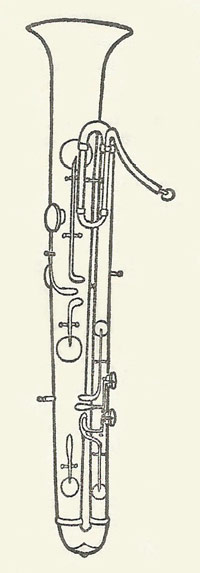cornett and key bugle families

Ophicleide.
The cornett and key bugle families are not to be confused with of the modern cornet, and the old spelling with the double "t" is used here, as it commonly has been by other authors, to mark this essential distinction. The cornett and key bugle families, both now obsolete, have affinities (a) with the woodwind instruments, in the method of varying the notes by the use of holes in the tube; and (b) with the brass instruments in the fact that the vibrating agent is the lips of the player applied to a cup-shaped mouthpiece. The difference between the two families is that (a) in the cornett family the first octave of notes is obtained by successively uncovering the holes in the tube, and the second octave by doing the same and overblowing, whereas (b) in the key bugle family each note is obtained by uncovering a hole gives rise to a series of notes, i.e. a section of the harmonic series.
The cornett family for centuries consisted of merely a wooden tube, usually leather-covered (occasionally an ivory tube), either straight or curved (in the arc of a circle or in two such arcs like a flattened "S", or, in the case of one member of the family, in a zigzag shape) or turned back on itself like a bassoon. Its members have been as follows (a) small cornett, straight or arc-shaped, and with a compass of a fourth below that of the cornett proper; (b) cornett proper (the one intended when the noun is used without any adjective), like the preceding but for pitch; (c) great cornett, S-shaped and tenor in pitch; (d) serpent, a later (16th-century) form, of bass pitch, 8 feet long and hence zigzag shaped as its name suggests, to bring its whole tube within reach of the player's fingers; (e) bass horn or keyed horn, no horn at all but an improved form of the serpent, without its wriggles and merely bent back on itself; (f) Russian bassoon, a variety of the preceding.
The members of the key bugle family were: (a) key bugle ("keyed bugle"), a treble instrument of the ophicleide type; ophicleide, of brass and shaped like its colleague of the other family, the bass horn (three sizes existed, alto, bass, and double bass, but only the bass was ever much used and it is now completely superceded by the bass tuba.
The cornett is mentioned in English writings as early as the 10th century. In the directions for Shakespeare's plays it is called for, and it had some church use in both France and England. Bach prescribes its use in 11 of his church cantatas, almost always to support the treble voices in a chorale melody. The serpent enjoyed perhaps its greatest popularity in France, where in the 18th century it was much in use as a church instrument: some English players of it were famous, and it was much heard in wind-bands and also in the orchestra. The bass horn and Russian bassoon had short careers at the end of the eighteenth century and beginning of the nineteenth.
The ophicleide had a part in orchestral scores of Mendelssohn, Berlioz, Wagner, and other notable composers, and was much heard in wind-bands. The key bugle was introduced about 1810 and enjoyed about a quarter of a century of popularity, losing this when the modern cornet came on the scene.


